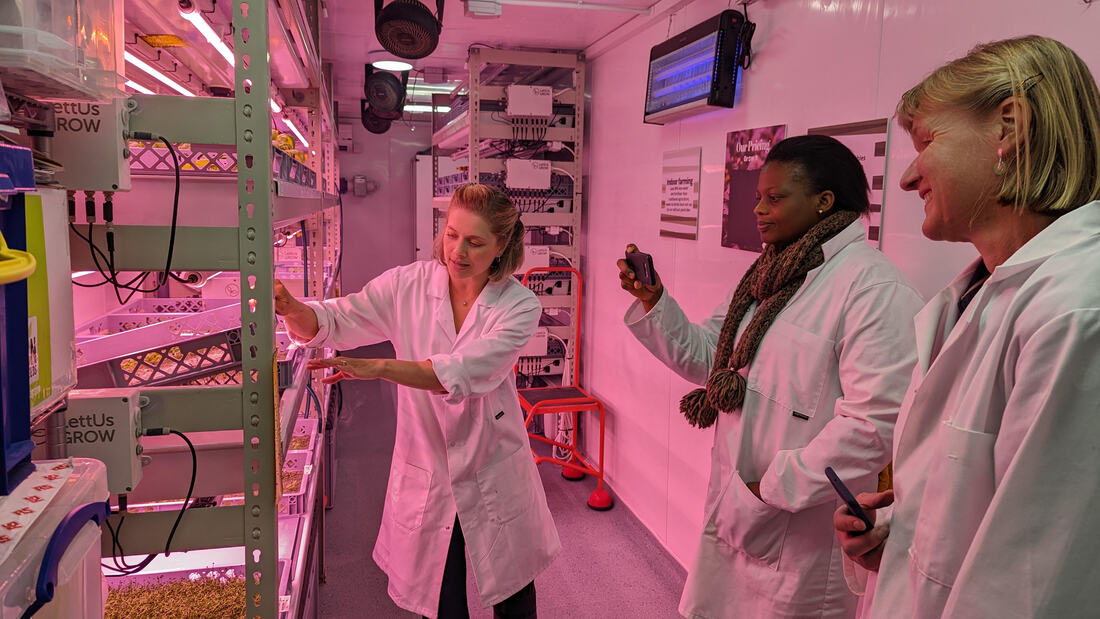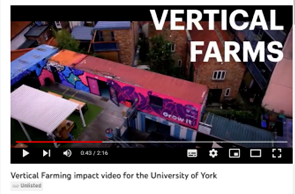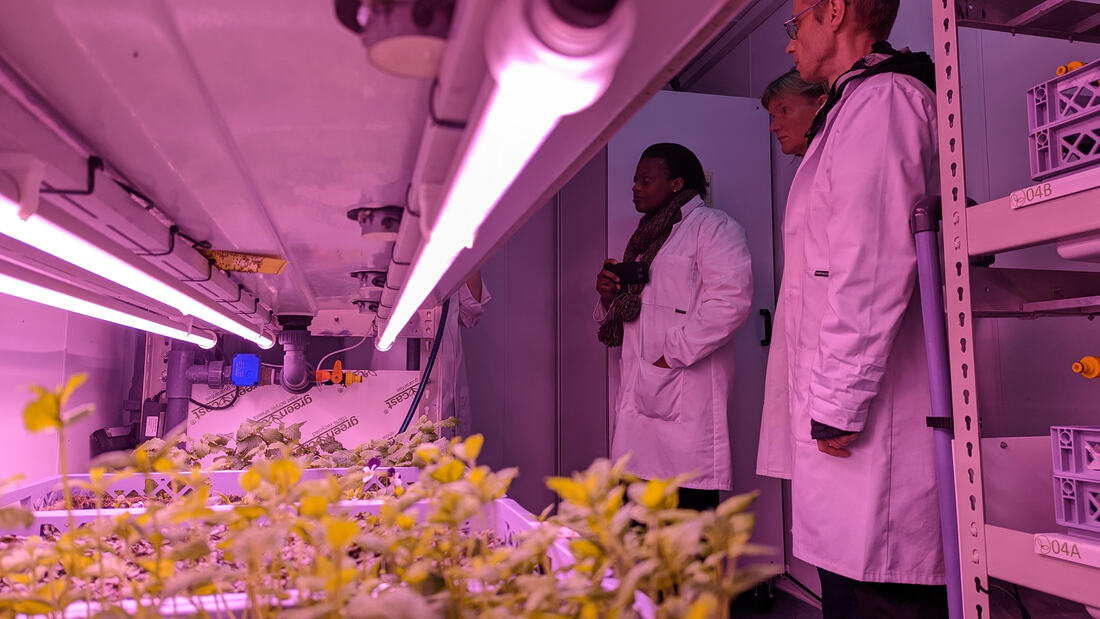|
With support from the STFC Food Network+ (SFN+), this project is modelling a future of local, ‘closed-loop’ urban food production systems where nothing goes to waste.  Vertical container farm in Spark! York in the city centre.Image credit: Spark! York Vertical container farm in Spark! York in the city centre.Image credit: Spark! York Our food systems are under immense pressure to produce more whilst simultaneously reducing pesticide and fertiliser use, carbon emissions, water use, and food miles. At the same time, the way we purchase food is undergoing dramatic change, with goods being increasingly sourced online, rather than from high streets. The sight of empty shop units may appear depressing, but for Peter Ball they represent an opportunity: a chance to address fundamental issues of food production whilst building thriving local communities. “I am a firm believer that many of these grand challenges we face with our current production systems can be addressed by returning manufacturing to a more local or regional level – whether it is food, drink, construction materials or other volume-low technology products” says Peter, a Professor of Operations Management at the University of York Management School. “Besides reducing the climate and environmental impact of food production, this can support local economies, give greater understanding about where our products come from, put unused space to work, and generate employment. It also presents the opportunity to build local circular economies, with ‘waste’ resources being recaptured and fed back into the system as input materials for new products.” For Peter, a particularly promising area is vertical farming, where plants are grown indoors in controlled environments. Besides reducing food miles by bringing agriculture into urban spaces, vertical farms are also more water- and space-efficient, and can remove the need for pesticides and herbicides. Additional benefits include the fact they can be set up practically anywhere (even underground), and that they allow year-round food production, sheltered from the elements. “Here in York, for instance, the University teamed up with LettUs Grow, an indoor farming technology company, to set up a vertical farm demonstrator project right in the heart of the city ” says Peter. “Not only can crops be used locally at the peak of freshness and nutrients but we can engage consumers in where their food comes from.” But isolated units don’t feed cities; for urban farms to have a significant impact on local consumption, these need to function as a network with their outputs matching consumer demands. But Peter believes this should go even further. His vision is for vertical farms to be integrated with local waste flows, so that the remaining value in food and food production waste is immediately put to use in nourishing the next crop. Up to now, however, there has been very little data to indicate whether this could be possible – a problem which inspired Peter to apply for a SFN Scoping Grant. A model solution “A key issue with using food waste flows as inputs for growing systems is that these are highly variable and dynamic, so ensuring a consistent supply of the right nutrients can be challenging” Peter explains. “Our aim was to provide a digital demonstrator to model waste flows in urban areas and explore how these could be optimised to create food production systems using circular economy principles.” This drew upon Peter’s expertise in using simulation modelling (digital twins) to capture system behaviour and improve performance. To develop the model, Peter and his colleagues sourced live data on production from the vertical farm demonstrator in the centre of York. In addition, they used public data sources to generate information on potential locations and volumes of food waste outputs. In the model, the waste flows were processed by IntelliDigest digestors, which use enzymes from bacteria and plants to turn inedible food waste into a broth-like nutrient liquid. The team analysed the simulated data to see how closely the output matched the nutrient requirements of growing crops. From brewery waste to building materials Beyond fertiliser, the team were also keen to explore whether additional waste streams could be harnessed to provide construction materials for vertical farms, or even an energy source to keep them running. “One of the barriers to scaling up vertical farms is the high initial capital costs, and the considerable energy demands” admits Peter. The team partnered with a local brewery, Brew York , to obtain samples of spent grain waste from beer production. Project partner WASWARE, a company that specialises in turning waste materials into novel biocomposite materials, then processed these into bioresin, and in turn bioleather and bioboard. “These new materials showed strong potential for use in vertical farm construction” says Peter. “This has led to ideas not just around changing existing materials but changing how we design structures in the first place.” The next steps According to Peter, although the project’s findings are promising for vertical farm expansion, much work remains still to be done. “The next stage is to develop more sophisticated models with access to live data streams to populate them with real information. We also need to build more case studies that include other urban areas, including those in developing countries.” “This collaboration funded by the SFN Scoping Grant enabled a diverse group of organisations to apply expertise into a common challenge and test out ideas” he added. “We are now pursuing a larger collaborative project on nutrient cycling, and have just started a project to develop new building materials and challenge existing farm design norms.” The STFC code used for the model simulation can be found on GitHub. The project was a collaborative team effort involving both academia and business. The team members were: Ehsan Badakhshan (University of York), Peter Ball (University of York), Joseph Bell (Wasware Ltd), Nicola Holden (SRUC), Jens Jensen (STFC), Ifeyinwa Kanu (IntelliDigest Ltd), Lydia Smith (NIAB), and Xiaobin Zhao (Wasware Ltd). Find out more: Using machine learning to unlock the secrets of plant productivity - STFC Food Network+ IntelliDigest: an innovative solution to put food waste to work - STFC Food Network+
0 Comments
Your comment will be posted after it is approved.
Leave a Reply. |
AuthorJune 2024 - Archives
June 2024
Categories |
- Home
- Webinars and Events
- About the SFN+
- News
- Blog
- Expert Working Groups
- Funding
-
Publications
- Bioeconomy positioning paper
- SFN+ 5th Annual Conference
- OMM Policy Report
- ‘Multi-Stakeholder International One Day Workshop on Organic Agri-Food Value Chains for Net Zero’ Report
- SFN 2050 UK Net Zero Food report
- Sustainable Cold Food Chain Booklet
- Food Sensing Technologies for Safe and Nutritious Food
- Sustainable urban and vertical farming
- Projects
- Join/Contact Us



 RSS Feed
RSS Feed


